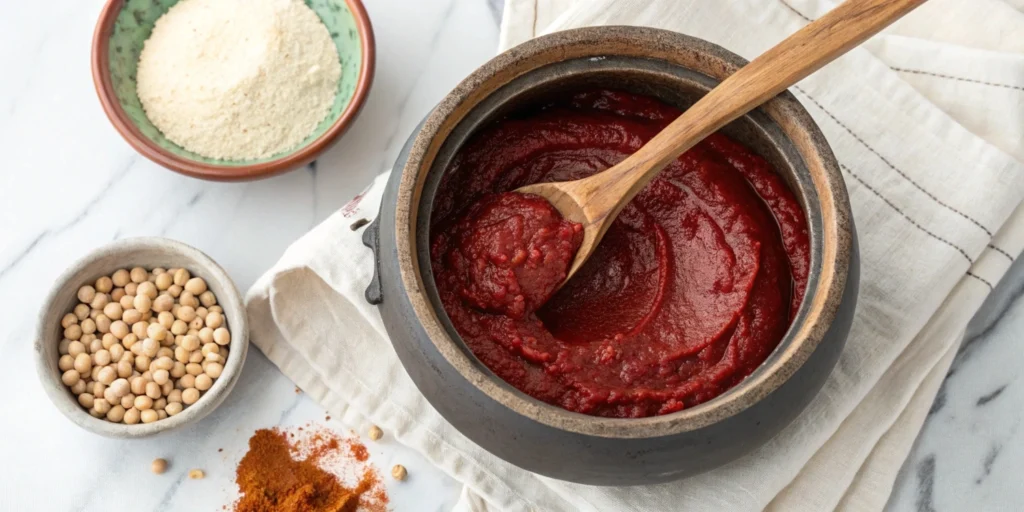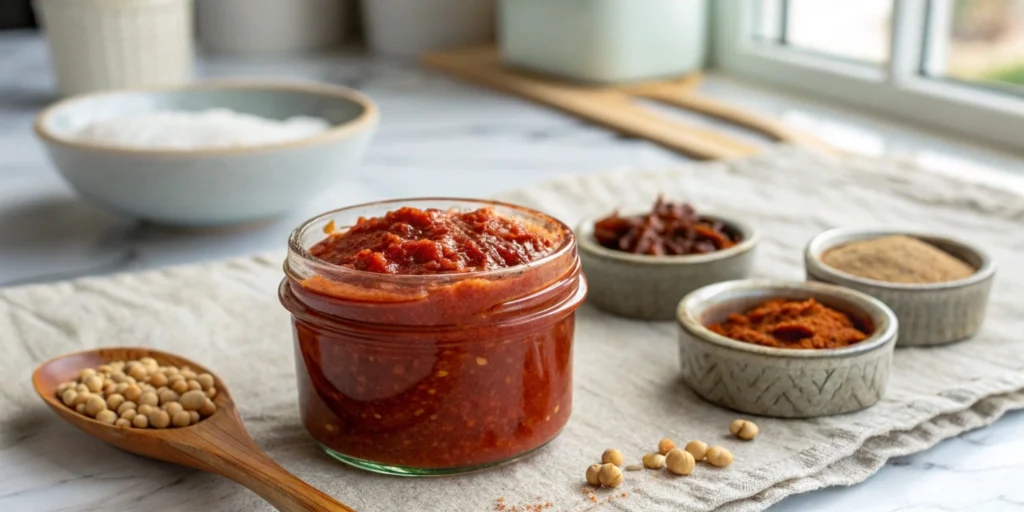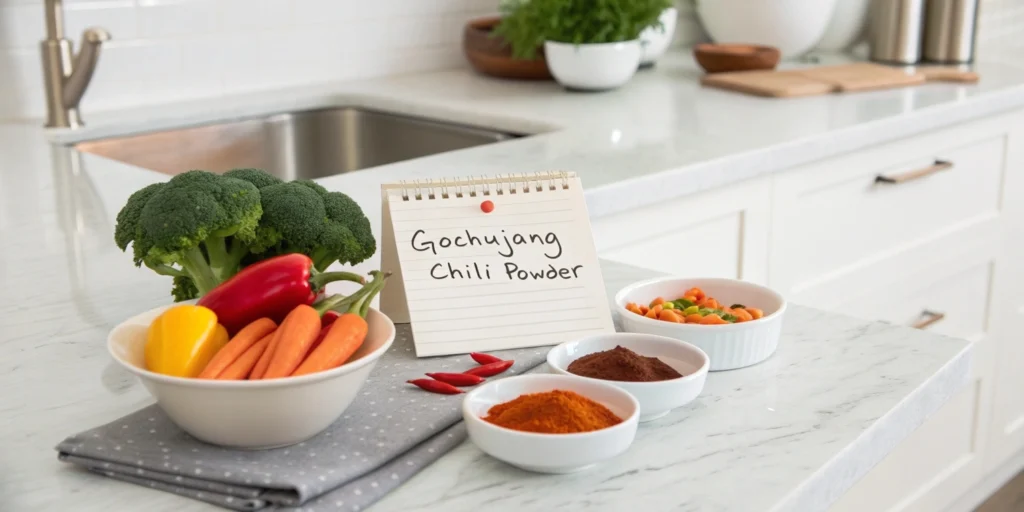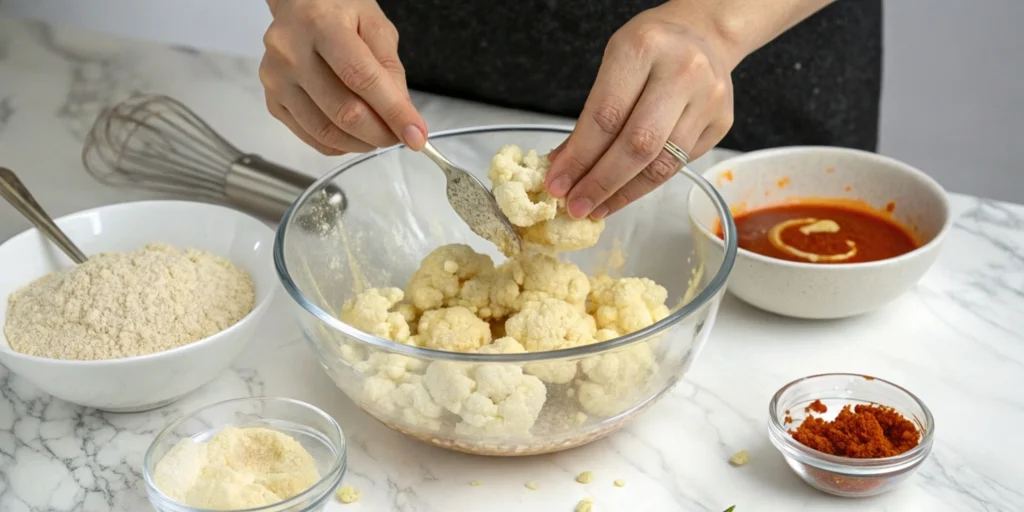
Table of Contents
When you hear the term gochujang (고추장), you might think of the fiery red paste tucked away in the condiment aisle of an Asian grocery store. For those of Korean descent, like myself, it’s much more than a pantry staple—it’s a tie to heritage, a flavor forged through time, and a bridge between generations. My grandmother’s well-worn recipe notebook, filled with handwritten notes in Korean, taught me not only how to craft authentic gochujang but also its significance in Korean culture and cuisine.
Here’s your chance to dive into the world of what is gochujang and uncover five severe truths about this cherished ingredient that has spiced up countless kitchens worldwide.
1. What Is Gochujang? A Fiery Korean Staple
Gochujang is a fermented chili paste that’s the backbone of Korean cooking. It’s made with just a handful of ingredients: chili powder for heat, fermented soybeans for depth, glutinous rice for sweetness, and salt to preserve and balance the flavor. The fermentation process transforms these components into a smooth, deep-red paste bursting with complex notes of heat, sweetness, and umami.
This unique flavor combination sets gochujang apart from other condiments. Unlike hot sauces that focus solely on spiciness, gochujang harmonizes flavors, making it the secret weapon in many Korean dishes.
2. Severe Fact: The Fermentation Process Is the Key
Fermentation lies at the heart of gochujang’s bold flavor and nutritional benefits. Traditional gochujang is made by mixing the base ingredients and allowing them to ferment for months—even years—in large earthenware pots called onggi (옹기). This process, which dates back centuries, is what gives gochujang its unmistakable depth and character.

During fermentation, beneficial microorganisms break down the soybeans and glutinous rice, creating a paste rich in probiotics and amino acids. These microscopic wonders not only enhance the taste but also boost the nutritional profile of the paste.
Unlike mass-produced versions, traditional gochujang contains no artificial preservatives, relying entirely on time and nature to develop its unique profile. My grandmother’s recipe dictated exact proportions and even specified the best times of year to begin fermentation—guidance I follow to this day.
3. Severe Health Benefits of Gochujang
While you may love gochujang for its flavor, its health benefits deserve just as much attention. Here are some powerful reasons to incorporate it into your meals:

- Boosts Metabolism: Capsaicin, the compound responsible for the heat in chili peppers, helps increase metabolic rate and promote fat burning.
- Rich in Antioxidants: Fermentation enhances the antioxidant properties of gochujang, which helps combat oxidative stress in your body.
- Gut-Friendly Probiotics: Thanks to its fermentation process, gochujang contains probiotics that support a healthy gut microbiome.
- Low in Fat, Big on Flavor: Adding just a dollop of gochujang can transform a dish without piling on unnecessary calories or fats.
Using gochujang in moderation lets you enjoy its health perks without overindulging in sodium or sugar.
4. How to Use Gochujang in Everyday Cooking
Whether you’re a seasoned cook or a curious beginner, gochujang is one of the most versatile ingredients you’ll ever encounter. It works equally well in traditional Korean dishes and experimental fusion recipes.
Traditional Dishes
If you’ve ever had bibimbap (mixed rice with vegetables), tteokbokki (spicy rice cakes), or jjigae (Korean stews), you’ve tasted the magic of gochujang. These classics rely on the paste for their signature heat and sweetness.
Recipe: Gochujang-Glazed Cauliflower Wings
Here’s how you can create a plant-based dish that’s both indulgent and nourishing:

Ingredients:
- 1 medium cauliflower, broken into bite-sized florets
- 1 cup all-purpose flour
- 1 cup water
- 1 teaspoon garlic powder
- 1 teaspoon onion powder
- Salt and pepper to taste
- 1 cup panko breadcrumbs
For the glaze:
- 3 tablespoons gochujang
- 2 tablespoons soy sauce
- 2 tablespoons maple syrup
- 1 tablespoon rice vinegar
- 1 teaspoon sesame oil
- 2 cloves garlic, minced
Instructions:
- Prepare the Batter: In a large bowl, whisk together flour, water, garlic powder, onion powder, salt, and pepper until smooth.
- Coat the Cauliflower: Dip each cauliflower floret into the batter, ensuring an even coat. Roll in panko breadcrumbs for extra crunch.
- Bake: Arrange the coated florets on a baking sheet lined with parchment paper. Bake at 425°F (220°C) for 25 minutes, flipping halfway through.
- Make the Glaze: While the cauliflower bakes, combine gochujang, soy sauce, maple syrup, rice vinegar, sesame oil, and minced garlic in a small saucepan. Simmer over medium heat until thickened.
- Toss and Serve: Coat the baked cauliflower with the glaze and garnish with sesame seeds and green onions. Serve hot.
Fusion Recipes
Gochujang isn’t just for Korean cuisine! Add it to:
- Marinades for chicken or tofu.
- Salad dressings for a spicy kick.
- Creamy pasta sauces for a unique umami depth.
5. Why the World Loves Gochujang
The appeal of gochujang isn’t limited to Korea. With its bold flavor profile, it has become a favorite among chefs and home cooks worldwide. As fermented foods gain traction for their health benefits, gochujang is riding this wave of popularity.
Restaurants are incorporating it into global cuisines, from spicy gochujang tacos to smoky barbecue sauces. Social media is flooded with creative recipes featuring this versatile paste, showcasing its potential to enhance both sweet and savory dishes.
FAQs About What Is Gochujang
Is Gochujang Very Spicy?
The spice level varies. While traditional gochujang packs a punch, its sweetness and umami balance the heat, making it approachable for most palates.
Can I Make Gochujang at Home?
Yes! While it takes time and effort, homemade gochujang allows you to control the ingredients and tailor the flavor to your preference.
Where Can I Buy Gochujang?
You can find gochujang in Asian grocery stores, specialty food shops, and online. Look for brands that use traditional fermentation methods for the best quality.
Is Gochujang Gluten-Free?
Not always. Traditional recipes use glutinous rice, but there are gluten-free versions available for those with dietary restrictions.
Conclusion: Add Gochujang to Your Culinary Arsenal
Gochujang is more than just a chili paste. It’s a symbol of tradition, a flavor powerhouse, and a nutritional gem. Whether you use it to elevate your favorite recipes or explore Korean cuisine, this versatile ingredient will transform your cooking.

Ready to try your hand at gochujang? Stock up on this essential paste and bring a touch of Korea to your table!
